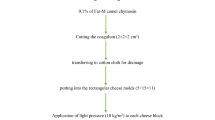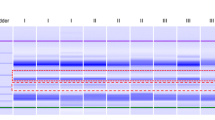Abstract
Jben is an Algerian traditional fresh cheese produced on a small scale in a limited area of east and west Algeria, in Maghnia and Nadrouma. It is manufactured from raw sheep, cow or goat milks, coagulated with dried flowers of wild thistle Cynara cardunculus L. without starter culture addition. In this work, Jben was made using cow and goat pasteurized milks to improve the microbiological quality. Milk was clotted with crude enzymatic extract of dried flowers of wild thistle C. cardunculus L. In order to obtain a better organoleptic characteristic, the assays of cheese making were realized with adding strains of lactic acid bacteria isolated from traditional cheeses. Physico-chemical and microbiological analyzes were carried out on the manufactured cheeses. Milk was clotted with 0.5% v/v by aqueous extract (40 g/L) of dried flowers of C. cardunculus L. Better organoleptic quality and higher cheese yield were obtained with goat milk. Cheese made from pasteurized goat’s milk added with Lactococcus lactis subsp. lactis, and that added with the mixture of lactic acid bacteria strains L. lactis subsp. lactis, Lactococcus raffinolactis, Leuconostoc mesenteroïdes ssp. mesenteroïdes, were the most appreciated. It is believed that the activity of L. raffinolactis in dairy products may contribute to their final sensory characteristics.



Similar content being viewed by others
References
AFNOR NFV09-021 (1991) Recueil de normes françaises, contrôle de la qualité des produits alimentaires, analyse sensorielle. «Collection of French standards, quality control of food products, sensory analysis». AFNOR, IBSN2-12-190843-9
Ayad EHE, Verheul A, Wouters JTM, Smit G (2002) Antimicrobial-producing wild Lactococci isolated from artisanal and non-dairy origins. Int Dairy J 12:145–150
Bernardeau M, Vernoux JP, Henri-Dubernet S, Guéguen M (2008) Safety assessment of dairy microorganisms: the Lactobacillus genus. Int J Food Microbiol 126:278–285
Bourgeois CM, Leveau JY (1991) Techniques d’analyse et de contrôle dans les industries agroalimentaires. «Analytical and control techniques in the agri-food industries». Tome 3, Technique et documentation, Lavoisier
Carminati D, Giraffa G, Quiberoni A, Binetti A, Suárez V, Reinheimer J (2010) Advances and trends in starter cultures for dairy fermentations. In: Mozzi F, Raya RR, Vignolo GM (eds) Biotechnology of lactic acid bacteria: novel applications. Wiley-Blackwell Publishing, Ames, IA, USA, pp 177–192
Cavalcanti MTH, Teixeira MFS, Lima Filho JL, Porto ALF (2004) Partial purification of new milk-clotting enzyme produced by Nocardiopsis sp. Bioresour Technol 93:29–35
Chazarra S, Sidrach L, Lopez-Molina D, Rodriguez-Lopez JN (2007) Characterisation of the milk-clotting properties of extracts from artichoke (Cynara scolymus L.) flowers. Int Dairy J 17:1393–1400
Dervisoglu M, Aydemir O (2007) Physicochemical and microbiological characteristics of Kulek cheese made from raw and heat-treated milk. World J Microbiol Biotechnol 23:451–460
Desfleurs M, Bailleul IB (1975) Dosage rapide de la matière grasse des fromages «Fast dosing of cheese fat». Lait 55:68–75
El Galiou O, Zantar S, Bakkali M, Laglaoui A, Centeno JA, Carballo J (2015) Chemical and microbiological characteristics of traditional homemade fresh goat cheeses from northern Morocco. Small Rumin Res 129:108–113
Fernández E, Alegría A, Delgado S, Mayo B (2010) Phenotypic, genetic and technological characterization of Lactococcus garvieae strains isolated from a raw milk cheese. Int Dairy J 20:142–148
Fox PF, Cogan TM, Guinee TP (2017) Factors that affect the quality of cheese. In: McSweeney PLH, Fox PF, Everett DW (eds) Cheese: chemistry, physics and microbiology, 4th edn. Academic Press, London, pp 617–641
Gonzalez-Fandos E, Sanz S, Olarte C (2000) Microbiological, physicochemical and sensory characteristics of Cameros cheese packaged under modified atmospheres. Food Microbiol 17:407–414
International Dairy Federation (1993) Milk: determination of nitrogen content, IDF standard no. 20B:1993, parts 1 and 2. IDF, Brussels
Irigoyen A, Izco JM, Ibanez FC, Torre P (2002) Influence of calf or lamb rennet on the physicochemical, proteolytic, and sensory characteristics of an ewe’s-milk cheese. Int Dairy J 12:27–34
Law BA (2001) Controlled and accelerated cheese ripening: the research base for new technology. Int Dairy J 11:383–398
Leroy F, De Vuyst L (2004) Lactic acid bacteria as functional starter cultures for the food fermentation industry. Food Sci Technol 15:67–78
Llorente BE, Obregon WD, Francesc XA, Nestor O, Caffini NO, Vairo-Cavalli S (2014) Use of artichoke (Cynara scolymus) use of artichoke (Cynara scolymus) flower extract as a substitute for bovine rennet in the manufacture of Gouda-type cheese: characterization of aspartic proteases. Food Chem 159:55–63
Mouzali L, Aziza M, Bensiameur-Touati K, Hellal-Benateya A (2004) Cardoon (Cynara cardunculus L.) used as vegetable rennet in an Algerian traditional cheese making (DJBEN). Acta Hortic 660:207–213
Pereira CI, Gomes EO, Gomes AMP, Malcata FX (2008) Proteolysis in model Portuguese cheeses: effects of rennet and starter culture. Food Chem 108:862–868
Sarmento AC, Lopes H, Oliveira CS, Vitorino R, Samyn B, Sergeant K, Debyser G, Van Beeumen J, Domingues P, Amado F, Pires E, Domingues MR, Barros MT (2009) Multiplicity of aspartic proteinases from Cynara cardunculus L. Planta 230:429–439
Silva SV, Malcata FX (2000) Action of cardosin A from Cynara humilis on ovine and caprine caseinates. J Dairy Res 67:449–454
St-Gelais D, Turcot S, Ould Baba Ali A (2005) Chemical composition and properties of milk from five goat breeds. Milchwissenschaft 60:140–143
Tavaria FK, Sousa MJ, Malcata FX (2001) Storage and lyophilization effects of extracts of Cynara cardunculus L on the degradation of ovine and caprine caseins. Food Chem 72:79–88
Zitoun OA, Benatallah L, Ghennam EH, Zidoune MN (2011) Manufacture and characteristics of the traditional Algerian ripened Bouhezza cheese. J Food Agric Environ 9:96–100
Author information
Authors and Affiliations
Corresponding author
Additional information
Publisher's Note
Springer Nature remains neutral with regard to jurisdictional claims in published maps and institutional affiliations.
Rights and permissions
About this article
Cite this article
Benheddi, W., Hellal, A. Technological characterization and sensory evaluation of a traditional Algerian fresh cheese clotted with Cynara cardunculus L. flowers and lactic acid bacteria. J Food Sci Technol 56, 3431–3438 (2019). https://doi.org/10.1007/s13197-019-03828-0
Revised:
Accepted:
Published:
Issue Date:
DOI: https://doi.org/10.1007/s13197-019-03828-0




